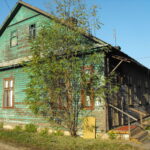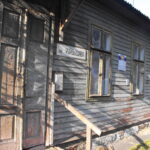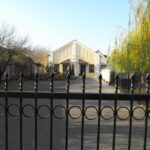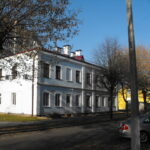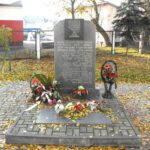Before the start of World War ll on September 1, 1939, Brest and Terespol were both part of Poland. Terespol is on the west side of the Bug River and Brest is on the east side, so members of the Goldsztern family moved easily between Terespol and Brest (Brisk); the two entities had been closely intertwined for centuries.
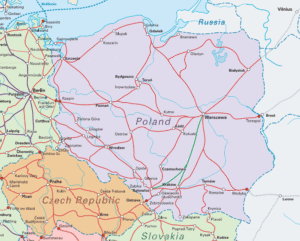
The Molotov-Ribbentrop non-aggression pact of August 3, 1939 placed Brest under the Soviet Union’s sphere of influence and Terespol under the German’s.
Germany invaded Poland from the east on September 1, 1939. Fayvel “Shraga” Goldsztern was born on September 4 in Terespol; his father searched for days to find someone to come help his wife Chaya deliver their third child. Two weeks later, the family, consisting of Yankel, Chaya, Perla, Rivkele and the newborn Fayvel, fled to Brest, where a number of Yankel’s siblings and their families lived.
A few days later, on September 17, Soviet troops invaded Poland from the east and met the advancing from the west near Brest-Litovsk. Brest was taken by the Germans and on September 22, handed over to the Russians. Poland was officially partitioned on September 29, with the Bug River constituting the new border between the German and Soviet occupied parts of Poland. The Soviet Union annexed the part of the province under their control and began mass deportations of Poles and Jews to Siberia.
With the expansion of Soviet-controlled territory, any Goldsztern’s still in Terespol now found themselves in German territory; the rest of the Goldsztern extended family was in the Soviet Union (Brest). Our family could not have been in a more precarious position.
Can you imagine? Within the space of a few weeks your country is attacked and occupied, a child is born, you flee across the river with three small children to what you think will be safety, the army that occupies your country shows up in your safe haven a few days later and hands everything over to another occupying power. All this in less than a month. And then everything changes less than two years later.
Germany broke the non-aggression pact on June 22, 1941 and invaded the Soviet Union in what was called “Operation Barbarossa”.

The SS arrived in Brest on June 24, 1941. Jewish residents were registered in November by the Nazis and by December 15, the Ghetto had been established. At that time Uszer’s son Avram lived at 64 Dolgaya Street and Chaim David lived at 80 Pervogo Maya Street. The south-eastern section of Dolgaya, or Dluga in Polish, was included in the Ghetto. Today that street is known as Kuibyshev and it appears to be a relatively major street (you can find Dluga Street by looking in the upper left quadrant of the map; you’ll see a circle with a cross on top next to the name “Dluga”).
At that time Uszer’s son Avram lived at 64 Dolgaya Street and Chaim David lived at 80 Pervogo Maya. The south-eastern section of Dolgaya (Dluga in Polish, the word means “long”) was in the center of the Ghetto, as were a synagogue and a yeshiva. Today that street is known as Kuibyshev.
The eighteen thousand Polish Jews who had survived months of deportations and mass executions (one of which took the lives of 5,000 Jews in one night, old and young,) were forced into the Ghetto. Uszer and Moshe Yudel Goldsztern, several of their children, their families and children of Tila Goldsztern Brandt and their families were among them. In 1936 Yudel Moshe’s son Shloima Goldsztern went to Palestine and thus survived; he later came to the US (information from my grandfather Sol “Szojel” Goldstein).
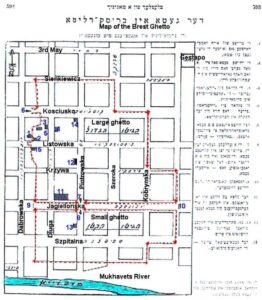
It appears that the family of Yankel and Chaya Goldsztern fled Brest some time before the establishment of the Ghetto, probably in 1941. They do not appear on any registration lists and we know from Pnina Goldsztern Shaufer and Shraga “Fayvel” Goldsztern that they were gone by then. Yankel’s youngest brother, Liber, went with them but was homesick and returned to Brest a month later. Later that year, possibly sometime in September, Yankel and his family were on a ship at Dnepropetrovsk, attempting to travel further into the Soviet interior. Yankel was pulled off the ship by Soviet military authorities and never seen again.
The Ghetto with the remaining population, about 16,000 Jews of all ages, was “liquidated” on October 15, 1942. Five thousand inhabitants were executed at the Brest Fortress (including residents of the old-age home and the orphanage, hospital patients and the Jewish Police) and the rest were taken about 70 miles northeast to Bronaya Gora by railroad car and shot in ditches.
A Yad Vashem website account states: “According to some sources an unknown number of Jews from Brest…were taken by truck to Bereza Kartuska (the town near Bronaya Gora), where the children were thrown into a pit and killed with grenades, while the adults were buried alive.” (https://www.yadvashem.org/untoldstories/database/index.asp?cid=1015)
(The Ghetto registration lists are now in the “Brest Ghetto Passport Archive” and are available through JewishGen.org and Yad Vashem. The latter also has lists of persecuted and murdered people from Brest. Together these documents, along with Pages of Testimony completed by Uszer’s two surviving grandchildren, Pnina Shaufer and Shraga Goldshtein, provide dates, addresses, names, and the likely fates of Uszer, Moshe Yudel and the Brandt families).
Much of the above historical information comes from Wikipedia, https://en.wikipedia.org/wiki/Brze%C5%9B%C4%87_Ghetto
.
